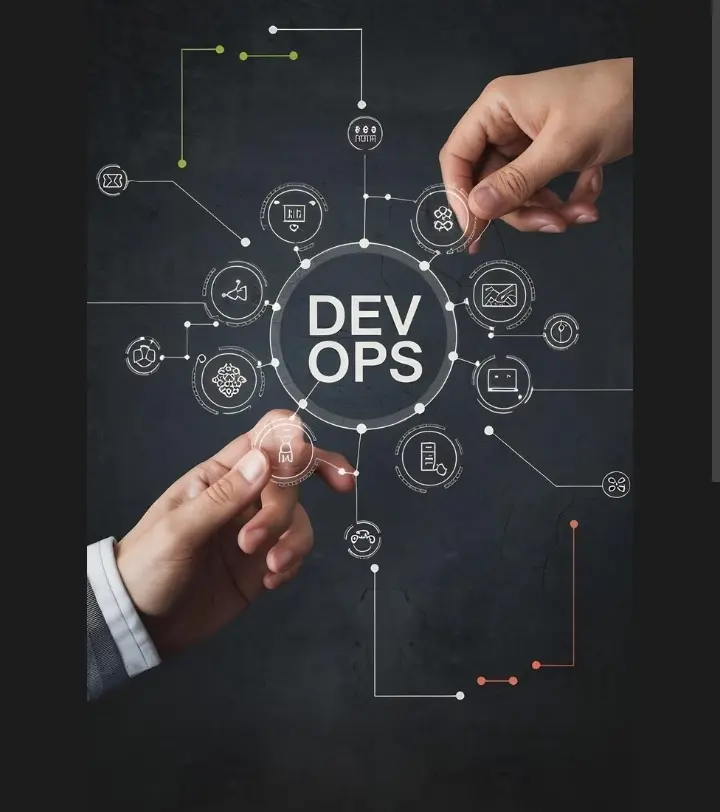Introduction
Imagine a world where almost every service you use such as banking, healthcare, travel, or online shopping depends on software running flawlessly behind the scenes. Every smooth app or website you interact with is the result of a careful dance between two critical teams; those who build the software and those who keep it running reliably. Without this coordination, even the simplest digital experience could quickly become chaotic.
For a long time, developers and operations teams worked separately. Developers were focused on building new features quickly, while operations teams were concerned with keeping systems stable and running smoothly. This difference in priorities often caused confusion, delays in releasing software, and arguments when problems arose.
To solve this, a new approach called DevOps was created. DevOps isn’t just a set of tools or rules; it’s a way of working that brings together people, processes, and technology. It helps teams deliver software faster, more reliably, and with better teamwork. Simply put DevOps acts as a bridge that connects development and operations so they can work together smoothly.
What Is DevOps?

The term DevOps blends “Development” (Dev) and “Operations” (Ops). Development focuses on designing, coding, testing, and improving applications. Operations ensure software runs smoothly, handling deployment, monitoring, and support.
DevOps refers to a collection of methods, technologies, and a collaborative mindset designed to streamline and unify the work carried out by software developers and IT operations. It focuses on empowering teams, improving communication and cooperation across departments, and leveraging automation to enhance efficiency and workflow integration.
The operations team makes sure software works smoothly in real life, taking care of things like deployment, keeping systems running, monitoring performance, and providing support. In the past, developers and operations worked separately, developers would finish their code and pass it on and operations would deploy it often without knowing the full details. This separation caused delays, confusion, and expensive mistakes.
DevOps changes this by bringing both teams together from the very beginning. It encourages teamwork, uses automation, and focuses on constant improvement throughout the entire process from writing the code to deploying it and keeping it running reliably.
The Evolution of DevOps
DevOps emerged as a solution to long-standing challenges in software development and IT operations. In the early years, organizations relied on the Linear Sequential Model—a rigid, step-by-step process where each phase had to be completed before moving to the next. This structure made development slow, expensive to change, and difficult to coordinate. The introduction of Agile in the early 2000s brought faster, iterative development, but it did not fully address operational delays, creating a gap between how quickly developers could build software and how slowly it was deployed.
Around 2009, DevOps began to rise as a movement that unified Development and Operations into a single collaborative workflow. Its core goal was to break down silos, encourage communication, and speed up delivery without sacrificing stability. Automation tools such as Jenkins, Docker, Kubernetes, and Infrastructure as Code transformed software delivery by enabling continuous integration, continuous delivery, and consistent environments.
The growth of cloud computing further accelerated DevOps, offering scalable, flexible, and automated infrastructure. Today, DevOps is viewed not just as a set of tools but as a culture focused on collaboration, shared responsibility, and continuous improvement. Its evolution continues through trends like DevSecOps, AIOps, GitOps, and platform engineering.
The Core Principles of DevOps
DevOps is built on five key principles that shape its success:
1. Collaboration and Shared Responsibility
DevOps breaks down silos, uniting developers, operations, testers, and even security professionals. Everyone shares the same goals, faster delivery, higher quality, and better user experience. This culture eliminates blame and encourages teamwork.
2. Automation
Automation is the engine of DevOps. Tasks like testing, building, and deployment are automated using tools such as Jenkins, Ansible, Docker, and Kubernetes. Automation reduces errors, ensures consistency, and accelerates delivery.
3. Continuous Integration and Continuous Delivery (CI/CD)
Continuous Integration (CI): Developers frequently merge code into a shared repository, triggering automated tests to catch issues early.
Continuous Delivery (CD): Code that passes tests is automatically prepared (and often deployed) to production, This CI/CD pipeline ensures faster, safer, and more frequent releases.
4. Continuous Monitoring and Feedback
Even after deployment DevOps keeps systems under constant watch. Monitoring tools like Prometheus, Grafana, and Nagios track performance and alert teams of issues in real-time, turning feedback into continuous improvement.
5. Infrastructure as Code (IaC)
With IaC, infrastructure is managed through code rather than manual setup. Tools like Terraform and AWS CloudFormation make it easy to replicate environments, scale quickly, and recover from failures all with precision and speed.
Developers and Operations (Working Hand-in-Hand)
DevOps transforms how developers and operations collaborate.
1. Faster Problem-Solving
When issues arise, developers understand the code while operations understand the infrastructure. Together, they pinpoint and fix problems quickly.
Example: If a website crashes, developers check the code, and operations check server loads, often resolving the issue within minutes.
2. Fewer Errors and Downtime
Automation reduces human mistakes. Automated testing and deployment pipelines ensure consistent, reliable releases. For instance automated scripts can deploy updates across hundreds of servers without downtime.
3. Frequent Smaller Updates
Instead of large risky releases, DevOps encourages small frequent updates improving responsiveness and stability.
Example: Facebook and Amazon deploy new versions several times per day.
4. Better Performance and Reliability
Operations monitor performance data in real time, which developers use to optimize code ensuring faster and more stable software.
5. Shared Ownership
Perhaps the biggest shift is in mindset. In DevOps, everyone owns the success and failure of the product. Developers care about uptime, and operations understand code changes creating a unified accountable culture.
Security in the Pipeline
As security becomes more critical, DevSecOps integrates security practices directly into DevOps workflows. Automated vulnerability scans, compliance checks, and code analyses are built into CI/CD pipelines to ensure that rapid delivery doesn’t compromise safety.
Real-World Examples of DevOps Success
Netflix
Netflix deploys code thousands of times per day. Its “Chaos Monkey” tool intentionally breaks parts of the system to test resilience ensuring seamless streaming for millions of users.
Amazon
Amazon pioneered continuous deployment, releasing updates every few seconds. DevOps has enabled its near-perfect uptime and global scalability.
NASA
Even space missions rely on DevOps. NASA uses automation and continuous monitoring to process vast amounts of spacecraft data efficiently and reliably.
Benefits of DevOps
1. Speed and Efficiency
Automation and CI/CD pipelines drastically shorten development cycles, allowing rapid innovation and quick market response.
2. Improved Collaboration
Shared tools and goals remove barriers between teams, leading to smoother communication and faster resolutions.
3. Higher Quality
Continuous testing and monitoring detect issues early, ensuring reliable, high-performing applications.
4. Reduced Costs
Automation and proactive monitoring cut operational costs by minimizing downtime, manual work, and late-stage fixes.
5. Scalability
Cloud-native DevOps and containerization (Docker, Kubernetes) make systems highly scalable and adaptable to demand spikes.
6. Customer Satisfaction
Frequent, stable updates and quick responses to feedback lead to happier, more loyal customers.
Challenges in Adopting DevOps
Despite its many benefits, DevOps adoption isn’t always easy. Common challenges include:
1. Cultural Resistance: In many organizations, people are used to doing things a certain way. When DevOps is introduced with new tools, automation, and new ways of working some team members may feel threatened. They might fear losing their jobs to automation, having to learn new skills, changing their familiar routine, and this resistance can slow down DevOps adoption.
To overcome this, organizations must communicate clearly, involve teams early, and show them how DevOps makes their work easier not replaces them.
2. Skill Gap:
DevOps requires cross-disciplinary skills, this is not just about coding, and it’s not just about operations it combines both. A DevOps engineer needs to understand basic programming, Automation tools, Cloud services, Infrastructure and servers, Monitoring and security, Because of this; many teams may lack some of these skills.
Organizations need to provide training, workshops, mentorship, and continuous learning opportunities to bridge these gaps.
3. Tool Complexity:
DevOps uses a lot of tools like Git for version control, Jenkins for CI/CD, Docker for containers, Kubernetes for orchestration, and many more. When companies use too many tools without a clear standard, problems happen, Teams get confused, Processes become inconsistent, and Work becomes harder instead of easier.
Standardizing tools and choosing only what the team truly needs helps avoid confusion and ensures everyone works the same way.
4. Security Risks:
DevOps encourages fast releases sometimes multiple updates in a single day. But releasing fast without proper security checks can lead to Vulnerabilities, Data leaks and Security breaches. To prevent this security must be part of the DevOps process from the beginning not an afterthought.
This is why many organizations adopt DevSecOps, which means integrating security into every stage of development.
How organizations can overcome these challenges

Organizations can overcome DevOps challenges by building a strong foundation of learning, collaboration, and security-focused practices. First, promoting a culture of continuous learning is essential. Teams need an environment where they feel encouraged to explore new tools, experiment with modern techniques, and embrace changes without fear. This mindset helps reduce resistance to new processes and boosts innovation.
Secondly, investing in proper training ensures that employees gain the skills needed for DevOps success. Many challenges arise from skill gaps, so companies should provide opportunities such as workshops, hands-on labs, mentorship programs, and professional certifications. These efforts help teams strengthen their knowledge in areas like automation, cloud technologies, infrastructure management, and coding. With better skills, teams can collaborate more effectively and deliver faster, more reliable results.
Finally, adopting DevSecOps integrates security into every phase of development rather than treating it as an afterthought. By embedding automated security checks into CI/CD pipelines, organizations can identify risks early, reduce vulnerabilities, and ensure compliance. Security teams, developers, and operations personnel work together from the start, leading to safer and more resilient software.
Overall, organizations that prioritize learning, upskill their workforce, and integrate security early will overcome DevOps challenges more effectively and create a culture of efficiency, innovation, and long-term success.
The future of DevOps
The future of DevOps is moving toward smarter, more automated, and fully integrated operations. DevSecOps embeds security into every step of development, ensuring faster delivery without compromising safety. AIOps uses AI and machine learning to predict failures, self-heal issues, and analyze large datasets, reducing downtime and improving efficiency. GitOps manages infrastructure through Git repositories, enabling automation, version control, and reliable, scalable environments. NoOps pushes automation further by minimizing human involvement, allowing teams to focus on building features while systems manage deployments and monitoring on their own. Serverless computing also supports this shift by eliminating the need to manage servers, offering automatic scaling and pay-as-you-go efficiency. Together, these trends point to a future where DevOps becomes increasingly intelligent, autonomous, and seamlessly integrated across development, operations, and security.
Conclusion
DevOps has fundamentally changed the way organizations develop, deploy, and maintain software. By breaking down the traditional barriers between development and operations teams, it encourages collaboration, shared responsibility, and effective communication. This approach ensures that software is not only built quickly but also delivered reliably.
At its core, DevOps is more than just a collection of tools or processes—it is a mindset. It emphasizes continuous improvement, adaptability to change, and a strong focus on customer satisfaction. Team works together to identify problems early, automate repetitive tasks, and continuously refine their workflows, creating a culture of learning and innovation.
In today’s digital world, where speed, efficiency, and reliability are key to success, DevOps acts as a bridge between ideas and execution. It enables organizations to innovate faster while maintaining high-quality standards.
Ultimately, DevOps is not just about how software is built—it is about how modern success is designed and achieved. By combining technology, people, and processes in a seamless way, DevOps empowers businesses to stay competitive, deliver value consistently, and respond effectively to an ever-changing technological landscape.